New HPLC Systems and Related Products: A Brief Review
LCGC North America
This installment describes HPLC and related products introduced at Pittcon 2017 Chicago and in the year prior. It highlights new HPLC systems, modules, and software, with innovative features and significant benefits to the users.
This installment highlights new high performance liquid chromatography (HPLC) systems, modules, and software that were introduced at Pittcon 2017 and during the year prior, and describes their innovative features and significant benefits.
This annual review of new high performance liquid chromatography systems and related products covers products introduced during the last 12 months. The majority of the products were launched at Pittcon 2017.
The Pittsburgh Conference on Analytical Chemistry and Applied Spectroscopy (Pittcon) is one of the world’s largest conference on laboratory science. The 69th Pittcon was held at McCormick Place in Chicago, the largest conference center in the United States, from March 5 to 9, 2017. The last time Pittcon was held in Chicago was in 2014 (and 2011 prior), and it will be there again in 2020. Note that Chicago, Orlando, Philadelphia, New Orleans, and Atlanta are the cities selected for hosting Pittcon, with Chicago in the rotation every 3 years and the others about every 6 years. This frequency makes sense since Chicago is the third largest city in the U.S. and is also an industrial, agricultural, financial, transportation, and communication center. We had great weather this year at the conference with many sunny days and spring-like temperature in the 50s.
Pittcon is impressive with ~2000 presentations, 100+ short courses, and a huge exposition with over 800 exhibitors, including over 120 new manufacturers displaying for the first time. Although the number of attendees has been dropping in recent years, registration hit 13,300 after three days. With open admission on Thursday, a total of above 14,100 was expected, which is very good news for the conference and an indication of a healthier economy and positive outlook for instrumentation. This year’s conference featured a plenary lecture by Dr. Karl Deisseroth, a professor of bioengineering at Stanford University, on insights on optogenetic proteins using electron microscopy and mass spectrometry (MS). Once again, Pittcon 2017 provided a “Mecca” for analytical chemists and a premier venue for instrument manufacturers.
Megatrends in HPLC Equipment
The perfect marriage of ultrahigh-pressure liquid chromatography (UHPLC) and MS instruments continues to be the megatrend in chromatography in recent years (1–5), even though this is another off year for new UHPLC system introductions. With many second-generation UHPLCs debuted by all major manufacturers in prior years (2,3), this year we are seeing mostly line extensions, application-specific systems, modules (particularly new MS or MS add-ons), and software products.
Table I lists the new product introductions (arranged alphabetically by vendor name), followed by more-detailed descriptions or commentaries.

CLICK TABLE TO ENLARGE
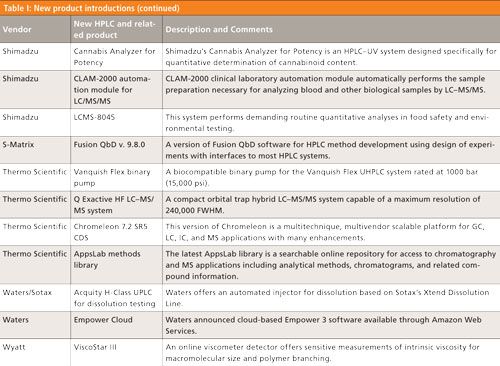
CLICK TABLE TO ENLARGE
New HPLC and UHPLC Systems and Line Extensions
New HPLC, UHPLC, supercritical fluid chromatography (SFC), ion chromatography (IC), modules, chromatography data systems (CDS), and related software are summarized in Table I and described with more details below.
Agilent 1260 and 1220 Infinity II systems-Two years ago Agilent introduced the 1290 Infinity II LC systems. This year, Agilent completed the InfinityLab LC Series with the 1260 and 1220 Infinity II systems, all to deliver full method compatibility. Innovative 1290 Infinity II LC technology is leveraged with the 1260 Infinity II Multisampler with dual-needle sampling and Vialsampler. A larger column oven, which fits 30-cm columns and can accommodate four columns with a single switching valve, and a range of detectors are common to both systems. The 1260 Infinity II pumps have a 600-bar pressure limit and are available in either stainless steel or bioinert format. The 1220 Infinity II system remains an integrated 600-bar system available with an isocratic or a dual-channel gradient pump that can be paired with a manual injector or an autosampler, a variable-wavelength UV detector or a diode-array detector, and external special detectors including a mass-selective detector. All systems can be operated with Agilent OpenLab CDS Software as well as third-party software with the universal Agilent Instrument Control Framework.
Bruker Elute LC series-Bruker introduces the Elute LC series systems for LC–MS analysis: SP (700 bar), UHPLC (1300 bar for ultrafast analysis), OLE (for online extraction) and HT (high-throughput with the new PAL3 autosampler).
Cromite portable HPLC-Cromite introduced a handheld, portable HPLC system that consists of an isocratic pump with a 275-bar or 4000-psi pressure limit and a max flow rate of 4 mL/min, and a UV–vis detector with a light-emitting diode (LED) source that provides up to four customizable wavelengths. The system is designed with novel approaches to mobile-phase storage and sample introduction and preparation, and it includes a single-ended leak-proof column. The system weighs 2.5 lb (1 kg) and has overall dimensions of 6.8 x 3.2 x 3.4 in. (173 x 81 x 86 mm). The device can be controlled from a PC, smartphone, or tablet via Bluetooth and can be powered off a 12-VDC power supply or external battery. The company is targeting applications in education, environmental and production QC testing with this offering. Figure 1 shows an example chromatogram obtained using the Cromite portable HPLC system.
Figure 1: An example chromatogram obtained using Cromite's portable HPLC system. Column: 100 mm x 3 mm, 5-µm dp Cromite C18; mobile phase: 70:30:0.5 (v/v/v) water–acetonitrile–acetic acid; detection: UV absorbance at 275 nm; flow rate: 1 mL/min.
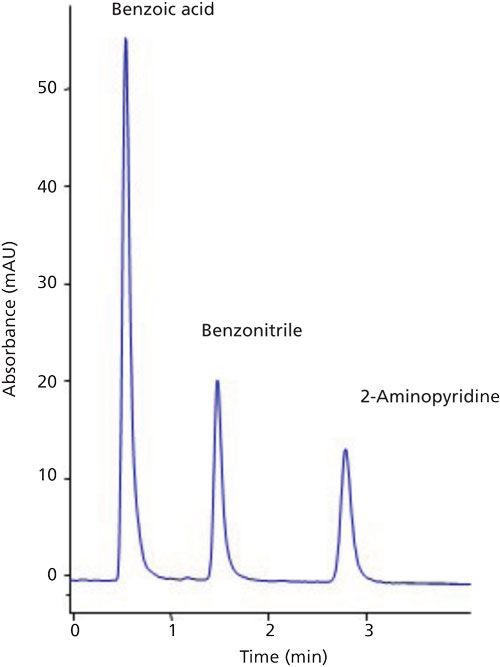
Knauer Azura Analytical and Semi-Prep HPLC-Knauer offers the Azura as a system solution for analytical to preparative HPLC. The analytical systems are available with binary or quaternary pumps (stainless steel at 700 and 1000 bar as well as a biocompatible, ceramic version at 400 bar). The semipreparative 200-bar systems are capable of flow rates as high as 50 mL/min and are available in both stainless and biocompatible formats. These systems can be configured with appropriate autosamplers, column ovens, and UV–vis, refractive-index, and diode-array detectors. The systems can be controlled by a controller, a mobile tablet, or a chromatography data system (CDS) such as OpenLAB EZChrom, ClarityChrom, and Chromeleon.
Prolab Instruments ZirconiumHT-The Zirconium High-Throughput UHPLC system is a micro-UHPLC system with a novel trapping column configuration for loading and analyzing samples at the same time using only one binary pump. Suggested applications are 2D micro and nano-LC analyses.
Shimadzu Cannabis analyzer-The Shimadzu Cannabis analyzer is a HPLC–UV system designed specifically for quantitative determination of cannabinoid content for potency with three method packages optimized for high-throughput, high sensitivity, and high resolution. Figure 2 shows an example chromatogram for potency testing of 11 cannabinoid standards on the system.
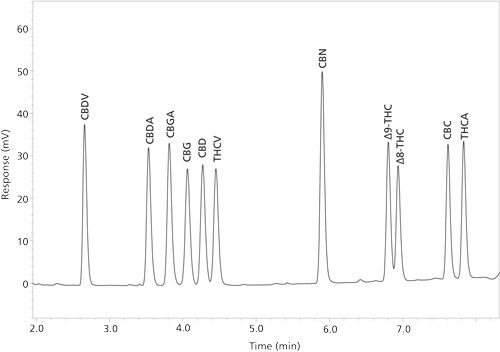
Sotax Xtend On-Line Dissolution with Waters Acquity H-Class UPLC-For those who have been waiting for a modernized replacement of the Alliance-based 2695D automated dissolution analyzer, the wait is over. Waters, in conjunction with Sotax, now offers an automated UHPLC system based on the Acquity H-Class UPLC system and Sotax’s dissolution testing apparatus with Sotax’s sample manager (SAM) to allow sample withdrawals, fractions collection, and autoinjections from USP dissolution systems.
Bonna-Agela OCTOPUS purification system-Bonna-Agela Technologies (acquired by Danaher last year) introduced a flexible and easy-to-use modular purification system for both flash and preparative HPLC with a family of four pumps (1–200 mL/min and pressure limits of 14–200 bar [200–3000 psi]) that can be equipped with automatic fraction collection, an autosampler, a column oven–switcher, and UV–vis, photodiode-array, evaporative light scattering, refractive-index, or MS detection.
Agilent 1260 Infinity II SFC-The Agilent 1260 Infinity II SFC system now offers an improved Multisampler autosampler, which uses an innovative feed injection principle that allows 0.1–90 µL of injection volume range with the higher sample capacity of 432 2-mL vials. The 1260 Infinity II SFC binary pump can provide pressures of 600 bar at up to 5 mL/min. The Infinity II SFC control module now offers full flow into evaporative light scattering or MS detection systems. A novel low dispersion nozzle with variable back-pressure settings enables outstanding peak shapes in this case.
Metrohm Eco IC-The Eco IC ion chromatograph is designed for routine analysis of anions, cations, and polar compounds in environmental testing and education applications. The system is complete with a suppressor, a conductivity detector, software, and an optional autosampler with up to 36 samples.
HPLC Modules
Cecil Instruments Electrochemical Detection Adept HPLC system-Cecil Instruments offers a modular HPLC system with electrochemical detection that supports DC-amperometric, scanning, and pulsed modes.
FF Runge Mikron detector series-These very compact photometric, fluorimetric, and conductivity HPLC detectors are based on LED technology.
Thermo Scientific Vanquish Flex binary pump-The Vanquish Flex binary system now features a binary high-pressure gradient pump with 2 x 3 solvent channels (1000 bar or 15,000 psi) and low gradient delay volume capable of delivering flow rates of up to 8 mL/min. The entire system provides a biocompatible flow path.
Wyatt ViscoStar III-The Wyatt ViscoStar III viscometer detector offers measurements of intrinsic viscosity for sensitive macromolecular size and conformation for polymer branching analysis. The detector uses Mark-Houwink-Sakurada parameters and hydrodynamic radii intrinsic viscosity calculations using Wyatt’s ASTRA software package in size-exclusion chromatography.
Mass Spectrometry
JASCO HPLC–MS and SFC–MS-JASCO offers the Advion Expression compact single-quadrupole MS system for its HPLC–MS (LC-4000 Series) and SFC–MS (SFC-400 Series SFC) systems with mass-triggered fraction collection and integrated system control using the ChromNAV CDS.
PerkinElmer QSight MS/MS system-The QSight triple-quadrupole system is a highly sensitive dual source self-cleaning LC–MS/MS analyzer that enables laboratories to test complex samples for food contaminants (such as pesticides) for regulatory compliance. QSight provides a complete pesticide solution from sample preparation, extraction to analysis, and reporting.
Sciex X500B QTOF-Sciex launches the compact X500B QTOF system designed to bring simplicity, performance, and robustness for biotherapeutic analyses. The new SCIEX OS software interface and BioPharmaView 2.0 processing software provide an integrated LC-MS solution for experts or novices performing standard biotherapeutic characterization.
Sciex QTRAP 6500+ LC–MS/MS-This combined quadrupole–ion trap system includes the highly sensitive triple-quadrupole 6500+ MS/MS system for high-throughput LC–MS/MS analysis for both small- and large-molecule quantitation. The MS system is equipped with the multicomponent IonDrive technology for enhancing sensitivity and is capable of six orders of magnitude of linearity, up to 20,000-u/s scan rates and 5-ms polarity switching.
Shimadzu LCMS-8045-Shimadzu’s LC–MS/MS-8045 system is a mid-range triple-quadrupole MS system that performs routine quantitative analyses in food safety and environmental testing. The instrument features a scan speed of 30,000 u/s without the loss of mass accuracy and a polarity switching time of 5 ms. It is operated using Shimadzu’s LabSolutions software. A dual electrospray ionization (ESI) and atmospheric-pressure chemical ionization (APCI) source is available
Shimadzu CLAM-2000 clinical laboratory automation module for LC–MS-The CLAM-2000 system automatically performs all of the sample preparation procedures necessary for analyzing blood (from blood collection tubes) and other biological samples by LC–MS/MS for therapeutic drug monitoring and testing of abused drugs.
Thermo Scientific Q Exactive HF-This compact quadrupole-orbital trap hybrid LC–MS/MS system designed for rapid quantitation of proteins, peptides, lipids, metabolites, and contaminants is capable of scan rates up to 18 Hz and a maximum resolution of 240,000 FWHM.
HPLC Accessories
Agilent 1290 Infinity II preparative fraction collector-This automated open-bed fraction collector allows efficient and flexible automated collection of up to 432 fractions or volumes up to 5.9 L triggered by time-, peak-, or mass-based mode.
Analytical Sales and Services Sentinel-The Sentinel is a fluid-level indicator for monitoring up to three bottles of waste or mobile-phase containers and is equipped with status display and alarm functions.
Biotech AB DEGASi Compact and Prep+ degassers-Two new degassers were introduced: The DEGASi Compact degasser with a small internal volume and the DEGASi Prep+ degasser that supports preparative HPLC, flash chromatography, and high-throughput applications.
ECOM ECF 2096 fraction collector-The ECF 2096 automated fraction collector collects up to 48 tubes of 8-mL volumes.
JM Science Sonic reservoir system-A monitoring system for up to three HPLC reservoirs and waste containers using sonic detection and an LED display.
Chromatography Data System and Other HPLC-Related Software
Agilent OpenLAB CDS 2.1-This newest version of OpenLAB CDS provides a networked or standalone environment that combines ease of use with rigorous regulatory compliance. This latest platform is an LC-, GC-, LC–MS-, and GC–MS-capable CDS for the QC laboratory with strong data integrity and audit trail review capabilities. Version 2.1 contains many new features including an extended support for non-Agilent instruments and improvements MS quantitation, peak integration and reporting. Figure 3 shows a screen shot of the Agilent OpenLAB CDS with four tiled panels for data processing, chromatograms, peak analysis, and processing methods.
Figure 3: A screen shot of the Agilent OpenLab 2.1 CDS showing four tiled panels on data processing, chromatograms, peak analysis, and processing methods.
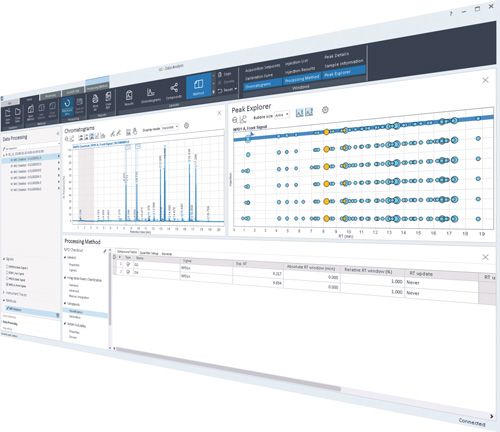
ChromPerfect SL-ChromPerfect introduces a CDS for small or mobile laboratories that controls up to four chromatographs with web-based and Windows 10 operating systems. It is compatible with tablets with data processing, reporting, and analysis functions.
DataApex Clarity v.7.2 CDS-The Clarity v.7.2 advanced CDS operates under Windows 10 and can be connected to four instruments and up to 32 data channels. Its optional control modules provide integrated control of selected instruments. Extensions are available for diode-array detectors, gel permeation chromatography (GPC) analysis, MS (single quadrupole and time of flight), and system suitability testing.
Waters Empower Cloud-Waters announced a release of cloud-based Empower 3 (feature release 4) available through Amazon Web Services in late 2017. This cloud-based CDS platform is particularly suited for pharmaceutical companies to reduce costs for implementation and maintenance and can support globally all subsidiaries and contract organizations.
ACD/Labs AutoChrom 2016 version-This automated HPLC method development software uses predictive simulation and can interface with both UV and MS detection. This version includes overlaid logD curves, better peak tracking, and an enhanced column data base with Tanaka parameters and superficially porous particle columns. It also has better connectivity to Chromeleon 7, Empower, and other MS data systems.
ACD/Labs LUMINATA-LUMINATA multitechnique software offers comprehensive data aggregation for impurity characterization and knowledge management applied to pharmaceutical development applications. Figure 4 shows a screen shot from this software displaying multiple panels including the overall synthetic scheme of the drug substance, a table of potential impurities, and the data associated with each impurity (HPLC chromatogram, UV, and mass spectra).
Figure 4: A screen shot of ACD/Labs LUMINATA software displaying multiple panels of an overall synthetic scheme of a drug substance, a table of potential impurities, and the data associated with each impurity (HPLC chromatogram, UV, and mass spectra).
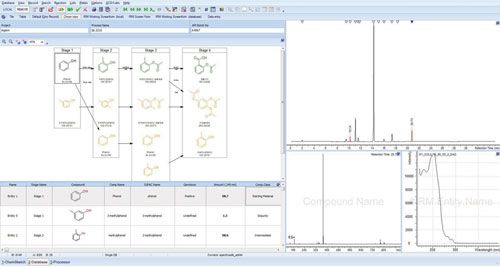
ACD/Labs MetaSense-MetaSense software uses LC–MS data as part of its workflow in metabolite identification. It facilitates faster, easier, and more accurate detection and identification of predicted and unexpected metabolites. Built on the ACD/Spectrus platform, MetaSense offers functionalities including the facilitation of decision-support and effective knowledge sharing throughout organizations as well as the ability to support LC–MS analytical data from most instrument vendors.
JASCO method scouting software-JASCO offers a method scouting software for automated solvent and column screening with up to 10 solvents and 10 columns. It also supports multiple detectors and can be configured for use with up to 30 columns and parallel screening.
S-Matrix Fusion QbD method development software v. 9.8.0-The Fusion QbD software for automated LC method development using principles of quality by design (QbD) and design of experiments (DOE) has been updated to include an enhanced user interface with an integrated chromatogram viewer, new project management capabilities with extended data security, additional support for GC and capillary electrophoresis (CE) method development, and increased instrument support for most HPLC and UHPLC systems, including hybrid systems.
Thermo Scientific Chromeleon 7.2 SR5 CDS-The Chromeleon CDS is a multitechnique, multivendor scalable platform for GC, LC, IC, and MS applications and includes a unique workflow automation called eWorkflows. The new platform is optimized for large-scale installation for thousands of users and instruments with data integrity features for regulatory compliance. This latest platform is designed particularly for MS analysis including biotherapeutics and is equipped with capabilities for automated target mass analysis for both LC–MS and GC–MS.
Thermo Scientific AppsLab methods library-The latest AppsLab library is a searchable online repository for easy access to chromatography and MS application databases including analytical methods, chromatograms and related compound information (1886 applications and 380 ready-to-use eWorkflows for Chromeleon CDS.
Concluding and Personal Remarks
Most analytical chemists come to Pittcon for professional development and networking. My schedule this year included teaching several short courses on HPLC, UHPLC, and method development, and chairing an invited symposium on UHPLC method development in pharmaceutical analysis. My networking events included a Chrom Mixer sponsored by Chrom Forum Delaware Valley in memory of Jack Kirkland (more than 500 attendees), a networking dinner event with the Chinese American Chromatography Association (CACA) attended by more than 120 conferees (featuring a lecture by Dr. Perry Wang of the US FDA on the perfect marriage of HPLC and MS), and the annual Pittcon presidential reception, where I personally thanked many Pittcon staff and program chairs.
I spent considerable time on the exposition floor to verify information on new HPLC products for this column installment. I returned home Thursday night, slept late and woke up to find 4 inches of snow on the ground in Connecticut. We were lucky as the weather can be unpredictable in early March in Chicago, as well as the Northeast. Rumor says that next year will be the last year for Pittcon in Orlando because the vendors complained about conference attendees visiting Disney World instead of the exposition. I love Orlando because of the excellent restaurants and the warmer weather-and I plan to visit both the exposition and the theme parks.
This installment provides a brief and nonexhaustive overview of new HPLC product introductions (systems, modules, MS, CDS, software, and related products) at Pittcon 2017 and during the prior year. Readers should contact manufacturers for additional technical details. Note that new HPLC columns are covered separately in LCGC’s “Column Watch” annual review by David Bell. The opinions expressed in this installment are the author’s own and bear no reflections on those of LCGC magazine, the Pittsburgh Conference, or any other organizations.
Acknowledgments
I wish to give thanks to the marketing and editorial staff of LCGC and all HPLC manufacturers for their timely responses to my numerous requests for information. I am particularly grateful to Davy Guillarme and Szabolcs Fekete of U. Geneva, Harika Vemula of U. Missouri at Kansas City, David Van Meter from EAG Laboratories, Hernan Fuertes from Ardelyx, and Matt Mullaney from Pentec Health for their invaluable editorial and technical input.
References
- C.H. Arnaud, Chem. & Eng. News94(24), 29–35 (2016).
- M.W. Dong, LCGC North Am. 34(4), 262–273 (2016).
- M.W. Dong, LCGC North Am.33(4), 254–261 (2015).
- D. Guillarme and M.W. Dong, Amer. Pharm. Rev. 16(4), 36–43 (2013).
- D. Guillarme and M.W. Dong (Eds.), UHPLC: Where We Are Ten Years After Its Commercial Introduction, Trends in Anal. Chem.63, 1–188 (2014).

Michael W. Dong is a principal of MWD Consulting, which provides training and consulting services in HPLC and UHPLC, pharmaceutical analysis, and drug quality. He was formerly a Senior Scientist at Genentech, Research Fellow at Purdue Pharma, and Senior Staff Scientist at Applied Biosystems/Perkin-Elmer. He holds a PhD in Analytical Chemistry from City University of New York. He has more than 100 publications and a best-selling book in chromatography. He is an editorial advisory board member of LCGC North America. Direct correspondence to: LCGCedit@ubm.com
For more information on this topic, please visit www.chromatographyonline.com/column-perspectives-modern-hplc
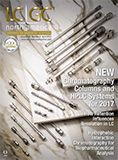















Common Challenges in Nitrosamine Analysis: An LCGC International Peer Exchange
April 15th 2025A recent roundtable discussion featuring Aloka Srinivasan of Raaha, Mayank Bhanti of the United States Pharmacopeia (USP), and Amber Burch of Purisys discussed the challenges surrounding nitrosamine analysis in pharmaceuticals.
Extracting Estrogenic Hormones Using Rotating Disk and Modified Clays
April 14th 2025University of Caldas and University of Chile researchers extracted estrogenic hormones from wastewater samples using rotating disk sorption extraction. After extraction, the concentrated analytes were measured using liquid chromatography coupled with photodiode array detection (HPLC-PDA).
Common Challenges in Nitrosamine Analysis: An LCGC International Peer Exchange
April 15th 2025A recent roundtable discussion featuring Aloka Srinivasan of Raaha, Mayank Bhanti of the United States Pharmacopeia (USP), and Amber Burch of Purisys discussed the challenges surrounding nitrosamine analysis in pharmaceuticals.
Extracting Estrogenic Hormones Using Rotating Disk and Modified Clays
April 14th 2025University of Caldas and University of Chile researchers extracted estrogenic hormones from wastewater samples using rotating disk sorption extraction. After extraction, the concentrated analytes were measured using liquid chromatography coupled with photodiode array detection (HPLC-PDA).
